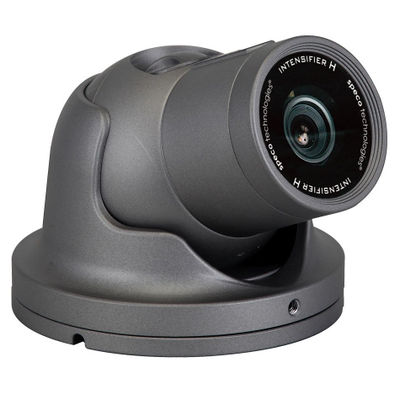Difference between revisions of "Speco Technologies"
| Line 49: | Line 49: | ||
* Exposure: Brightness 30 | * Exposure: Brightness 30 | ||
* Shutter ESC and then 1/60 to 1/10000 | * Shutter ESC and then 1/60 to 1/10000 | ||
* AGC | * AGC HIGH | ||
* Intensify Auto | * Intensify Auto (x512) | ||
* WDR ON (Level 11) | * WDR ON (Level 11) | ||
* Backlight Off or BLC | * Backlight Off or BLC | ||
Revision as of 21:52, 2 May 2015
Speco Technologies manufactures a line of exterior color surveillence cameras with DSP processing enabling low light level images of facilities without IR illumination, and of the night sky without external video integration.
Model HTINTD8 weatherproof camera
The spherical housing (they term it a "dome" camera) is clamped by the outer ring and can ge oriented in any direction. A cable with power, analog video, and motion detection relay closure exits the back of the ball opposite to the lens, and can be brought out under the ring. The camera is designed to operate looking down from an eave or ceiling, but the mounting can be reversed as shown to look up at the sky. Speco's website highlights these features:
- 2.8-12mm auto iris varifocal lens
- 1/3” Sony Super HAD™ CCD
- 700 lines of color resolution
- Amplify existing light with no distance limitations
- No problems caused by objects that reflect or absorb IR light sources
- Minimum illumination 0.00002 lux (Intensify @ 512x)
- Now with presets: Outdoor, Indoor, Elevator, Lobby, Hallway & Dark
- 12VDC / 24VAC dual voltage operation
- Full OSD operation and test monitor output
- 3-axis wall or ceiling mount
- External controls for zoom & focus
- EZ mount system simplifies installation
- Relay outputs for motion detection
- Weather resistant operation
- IP66 compliant
- Anti-moisture glass and circuitry eliminates fog or condensation under any weather condition
- 5 year warranty
The camera was available in March 2015 at prices from $230 to $250 through Amazon and other vendors.
In our uses primarily for sky cameras the video is sent to an Axis video server where it is capture either live or single frame for website use. Cameras are currently located
- On the Moore main building looking at the north celestial pole
- On the Moore roll roof looking at the celestial equator to the south
- On the Moore roll roof looking at the Moore main building (security)
- Inside the Moore RC24 dome for telescope monitoring
- Inside the CDK20 dome for telescope montoring
- On the Mt. Kent main building looking at from the zenith down to the southern horizon
Two of the cameras are expose the Sun directly during the day since they view the sky in the vicinity of the ecliptic, and both have handled the excess light without apparent damage. These same cameras respond with a blue sky and white clouds in the daytime, and stars fainter tha 6th magnitude at night.
Settings
For low light operation the DSP has to be configured before installation. This is done with small button under a removable O-ring sealed cover that is on the same side of the lens barrel as the focus and focal length adjustments. After setting the focal length to the shortest possible (for the widest field) and focusing for infinity, the DSP settings can be observed with a monitor attached to the video output. Alternatively, a small pin connector is provided under the cover. An adapter from that connector to a BNC connector is provided with the camera so that a portable monitor may be used after the camera is installed. The essential settings are
- Exposure: Brightness 30
- Shutter ESC and then 1/60 to 1/10000
- AGC HIGH
- Intensify Auto (x512)
- WDR ON (Level 11)
- Backlight Off or BLC
- Speco DNR ON (Level 15)
- Day/Night Color
Under "Special" on the menu there are image adjustments allowing vertical and horizontal flipping as needed.
Maintenance
We have had 3 cameras in exterior service since 2013. We added another at Mt. Kent in 2014, and two more inside the CDK20N and MORC24 domes in March 2015. One exterior camera developed sensitivty to moisture and was swapped with a new camera in the summer of 2014. That swapped camera is functioning well in another use where it is not exposed to moisture. Cameras should remain powered on continuously to warm their interior in cold weather and prevent condensation. The windows need occasional cleaning. We lightly lubricate the O-ring seals on the access port after use.
